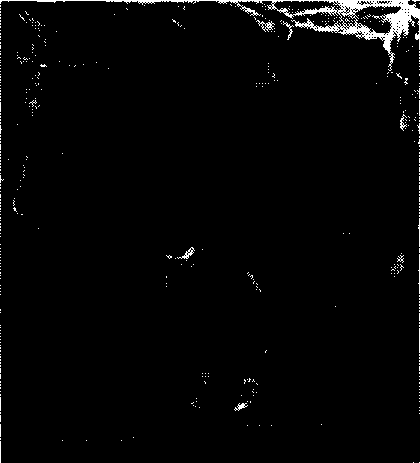Bacteriostatic porous polyelectrolyte material and its prepn process
A polyelectrolyte and porous material technology, applied in the field of porous materials, can solve the problems of limited application, and achieve the effects of short hemostasis time, strong sterilization ability and safe process
- Summary
- Abstract
- Description
- Claims
- Application Information
AI Technical Summary
Problems solved by technology
Method used
Image
Examples
Embodiment 1
[0016] A kind of preparation method of polyelectrolyte porous material, comprises the following steps: 1). First chitosan is dissolved in 1% acetic acid aqueous solution and obtains the chitosan solution of 2wt% (weight percent concentration), 2). Then it presses 1:3 weight ratio and 2wt% (weight percentage concentration) sodium alginate solution are mixed to obtain a chitosan / sodium alginate mixed solution, fully stirred to obtain a polyelectrolyte complex, homogenized and poured into a mold for freeze-drying; 3). Then the freeze-dried polyelectrolyte complexes in the mold were sequentially placed in CaCl 2 Soak in NaOH solution, wash with distilled water, and freeze-dry in a mold again to obtain an antibacterial polyelectrolyte porous material (chitosan / sodium alginate porous material), labeled as CSAL13. The results of the pore structure, water absorption rate and hemostasis time are shown in Figure 1-4 , figure 2 and Table 1.
Embodiment 2
[0018] The preparation method is the same as in Example 1, except that the mixing ratio of the chitosan solution and the sodium alginate solution is changed to 1:1 and 3:1, and the obtained products are labeled as CSAL11 and CSAL31 respectively. The results of the pore structure, water absorption rate and hemostasis time are shown in Figure 1-3 , Figure 1-2 , figure 2 and Table 1.
Embodiment 3
[0020] 1), a preparation method of antibacterial polyelectrolyte porous material, comprises the following steps: 1). First chitosan is dissolved in 1% acetic acid aqueous solution to obtain 2wt% chitosan solution, 2). Then it is pressed 1: 3 weight ratio is mixed with 2wt% sodium alginate solution to obtain chitosan / sodium alginate mixed solution, and sulfadiazine silver bacteriostatic agent is dispersed in chitosan / sodium alginate mixed solution, and its addition accounts for mixed solution 7% of the dry weight of the substance (that is, the weight of chitosan and sodium alginate), fully stirred to obtain the polyelectrolyte complex, homogenized and then poured into the mold for freeze-drying; 3). Then the polyelectrolyte after freeze-drying in the mold complex in turn in CaCl 2 After immersing in NaOH solution, wash with distilled water, freeze-dry in the mold again, obtain antibacterial polyelectrolyte porous material (porous material loaded with sulfadiazine silver), and t...
PUM
 Login to View More
Login to View More Abstract
Description
Claims
Application Information
 Login to View More
Login to View More - R&D
- Intellectual Property
- Life Sciences
- Materials
- Tech Scout
- Unparalleled Data Quality
- Higher Quality Content
- 60% Fewer Hallucinations
Browse by: Latest US Patents, China's latest patents, Technical Efficacy Thesaurus, Application Domain, Technology Topic, Popular Technical Reports.
© 2025 PatSnap. All rights reserved.Legal|Privacy policy|Modern Slavery Act Transparency Statement|Sitemap|About US| Contact US: help@patsnap.com



